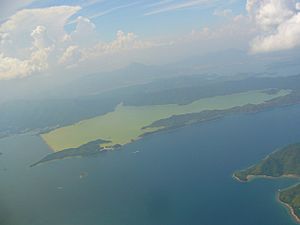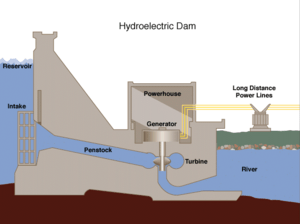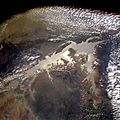Reservoir facts for kids
A reservoir is like a giant, man-made lake. People build reservoirs to collect and store water. This stored water can then be used for many important things, such as providing drinking water for cities or helping to make electricity.
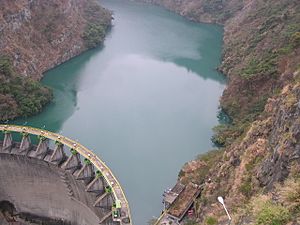
Contents
How Reservoirs Are Made
Reservoirs are built in different ways, depending on the land and what the water will be used for.
Valley Reservoirs
Many reservoirs are created by building a large wall, called a dam, across a narrow part of a valley. The valley's natural sides then act as the other walls of the reservoir.
When a dam is built, the river's water often needs to be moved temporarily. This is usually done by sending it through a special tunnel or a bypass channel.
Sometimes, when building a reservoir in a hilly area, engineers make an existing lake bigger. If the new water level goes higher than the natural hills around it, extra smaller dams are built on the sides to hold the water in.
Building these large reservoirs sometimes means that people living in the valley have to move. Important historical sites or rare natural areas might also need to be moved or protected. For example, the ancient temples of Abu Simbel in Egypt were moved before the Aswan Dam was built to create Lake Nasser.
If one big reservoir isn't possible, several smaller ones might be built in a chain. The River Taff valley in Wales has a chain of reservoirs like Llwyn-on, Cantref, and Beacons Reservoir.
Coastal Reservoirs
Coastal reservoirs are built right on the sea coast, usually near where a river meets the ocean. They are designed to store fresh water from river floods.
These reservoirs are a good choice because they don't take up valuable land further inland. Many coastal reservoirs have been built in places like Asia and Europe. Some famous examples include Saemangeum in South Korea, Marina Barrage in Singapore, and Plover Cove in Hong Kong.
Bank-Side Reservoirs
Bank-side reservoirs are built next to a river. Water is pumped or siphoned from the river into these reservoirs. They are often partly dug out of the ground and partly built up with a circular embankment or wall.
The bottom of the reservoir and its walls must be waterproof. In the past, this was done with special clay, but now modern rolled clay is often used. Water can stay in these reservoirs for several months. During this time, natural processes help to clean the water, reducing dirt and other unwanted things.
These reservoirs are helpful because they allow water to be taken from the river even when the river is very polluted or when there's a drought and the water level is very low. The water supply for London, England, uses large bank-side reservoirs like the Queen Mary Reservoir. Water is taken from the River Thames and River Lee and stored there.
Service Reservoirs
Service reservoirs hold water that has already been fully cleaned and is ready for people to drink. They are usually located close to where the water will be used.
Many service reservoirs are built as water towers, especially in flat areas, to keep the water high up. This helps create enough pressure for water to flow through pipes to homes. Other service reservoirs are built almost entirely underground, especially in hilly places.
For example, Thames Water in the United Kingdom has many underground reservoirs built in the 1800s. The Honor Oak Reservoir in London, finished in 1909, was once the largest brick-built underground reservoir in the world.
Service reservoirs help make sure there's always enough water for everyone, even during times of high demand. They also help water treatment plants work efficiently by allowing them to run at a steady pace.
A Look Back in Time
People have been building reservoirs for thousands of years!
Around 3000 BC, farmers in Arabia used the craters of old volcanoes to store water for their crops.
In India, where the climate is often dry, people developed ways to manage water early on. A reservoir was built at Girnar around 3000 BC. Ancient Greeks also had artificial lakes dating back to the 5th century BC.
The artificial Bhojsagar lake in India, built in the 11th century, was huge, covering about 650 square kilometers (250 square miles).
In Sri Lanka, ancient kings built large reservoirs to save water for farming. King Parākramabāhu I of Sri Lanka famously said, "Do not let a drop of water seep into the ocean without benefiting mankind." He created the large reservoir called Parakrama Samudra.
Why We Need Reservoirs
Reservoirs serve many important purposes in our daily lives.
Direct Water Supply
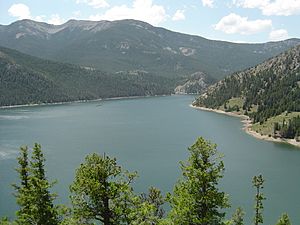
Many reservoirs provide raw (untreated) water to water treatment plants. These plants then clean the water so it's safe to drink.
The time water spends in a reservoir before being released is called retention time. This time is important because it allows dirt and tiny particles to settle to the bottom. Natural living things in the water, like algae and bacteria, also help to clean the water.
Making Electricity
Many dams with reservoirs are used to generate hydroelectricity. This means they use the power of falling water to create electricity.
Water from the reservoir flows through large pipes to turn special machines called turbines. These turbines are connected to generators that produce electricity. For this to work, the reservoir needs to be deep enough to create a strong flow of water.
Some hydroelectric reservoirs use a system called "pump-storage." Water is pumped up to a high reservoir when electricity is cheap (like at night). Then, when electricity demand is high, the water is released back down to a lower reservoir, turning turbines to make electricity.
Controlling Water Flow
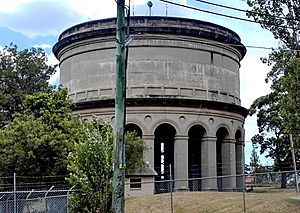

Reservoirs help control how water flows in rivers and other waterways.
- Water for Downstream: Water can be released from a reservoir high up in the hills to provide drinking water for towns and cities further down the river, sometimes hundreds of miles away.
- Water for Farms: Water from an irrigation reservoir can be sent through canals to water crops on farms. Reservoirs can also keep river levels steady so farmers can take water from the river for their fields.
- Stopping Floods: Some reservoirs are built to help prevent floods. They collect large amounts of water during heavy rain and then release it slowly over weeks or months. This stops too much water from rushing downstream all at once. The land behind these dams might even be used for parks or recreation when it's dry.
- For Canals: If a canal needs a steady supply of water, especially when it climbs hills using locks, a reservoir can be built to keep the water level just right.
- For Fun: Water can be released from reservoirs to create exciting white water conditions for sports like kayaking. Special releases, called freshets in Britain, are also made in rivers to help fish like salmon migrate and to improve fishing conditions.
Balancing Water Levels
Reservoirs can help balance the flow in rivers that are carefully managed. They take in water when there's a lot of it and release it when there's not much. This often requires special structures called spillways to control the water level.
Before a big storm, dam operators can estimate how much water the storm will add to the reservoir. If it looks like the reservoir might overflow, they slowly release some water beforehand. This way, the reservoir won't get too full, and areas downstream won't flood. Good weather forecasts are very important for this.
Examples of carefully managed reservoirs include Burrendong Dam in Australia and Bala Lake in North Wales.
Recreation and Fun
Many reservoirs are also great places for fun activities! People often enjoy fishing and boating on them. There are usually special rules to keep everyone safe and to protect the water quality and the natural environment.
Many reservoirs also encourage activities like natural history exploration, bird watching, landscape painting, walking, and hiking. They often have information boards to help people learn about the area and encourage responsible use.
How Reservoirs Work
Rainwater and groundwater (water from springs) flow into a reservoir and are stored there. If there's too much water, it can flow out through a specially designed spillway.
The stored water can be sent through pipes by gravity for drinking water, to make hydro-electricity, or to keep river flows steady for uses downstream. Sometimes, reservoirs are managed to hold back water during heavy rains to prevent or reduce flooding. Some reservoirs are used for many different things, so their operation can be quite complex.
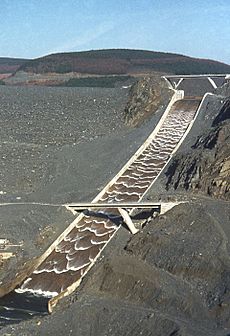
Most modern reservoirs have a special structure called a draw-off tower. This tower can release water from different levels of the reservoir. This is useful for getting water as the reservoir level changes. It also allows operators to release water of a specific quality into the river below. These releases are known as compensation water and are often required to keep the river healthy, support fish, or help industries and recreational activities downstream.
Famous Reservoirs
Images for kids
-
Kardzali Reservoir in Bulgaria is a reservoir in the Rhodope Mountains.
-
Lake Osceola on campus of the University of Miami in Coral Gables, Florida, May 2006
-
Cherokee Reservoir in Tennessee. It was formed after the impounding of the Holston River Valley by the Tennessee Valley Authority in 1941 as a part of the New Deal's efforts to bring electricity to the Tennessee Valley.
-
The Queen Mother Reservoir in Berkshire, England is an example of a bank-side reservoir; its water is pumped from the River Thames.
-
Brushes Clough Reservoir, located above Shaw and Crompton, England.
-
A Great cormorant (Phalacrocorax carbo) perched on a buoy at Farmoor Reservoir, Oxfordshire. As reservoirs may contain stocks of fish, numerous water-bird species may rely on reservoirs and form habitats near them.
-
Liptovská Mara in Slovakia (built in 1975) – an example of an artificial lake which significantly changed the local microclimate.
See also
 In Spanish: Embalse para niños
In Spanish: Embalse para niños


